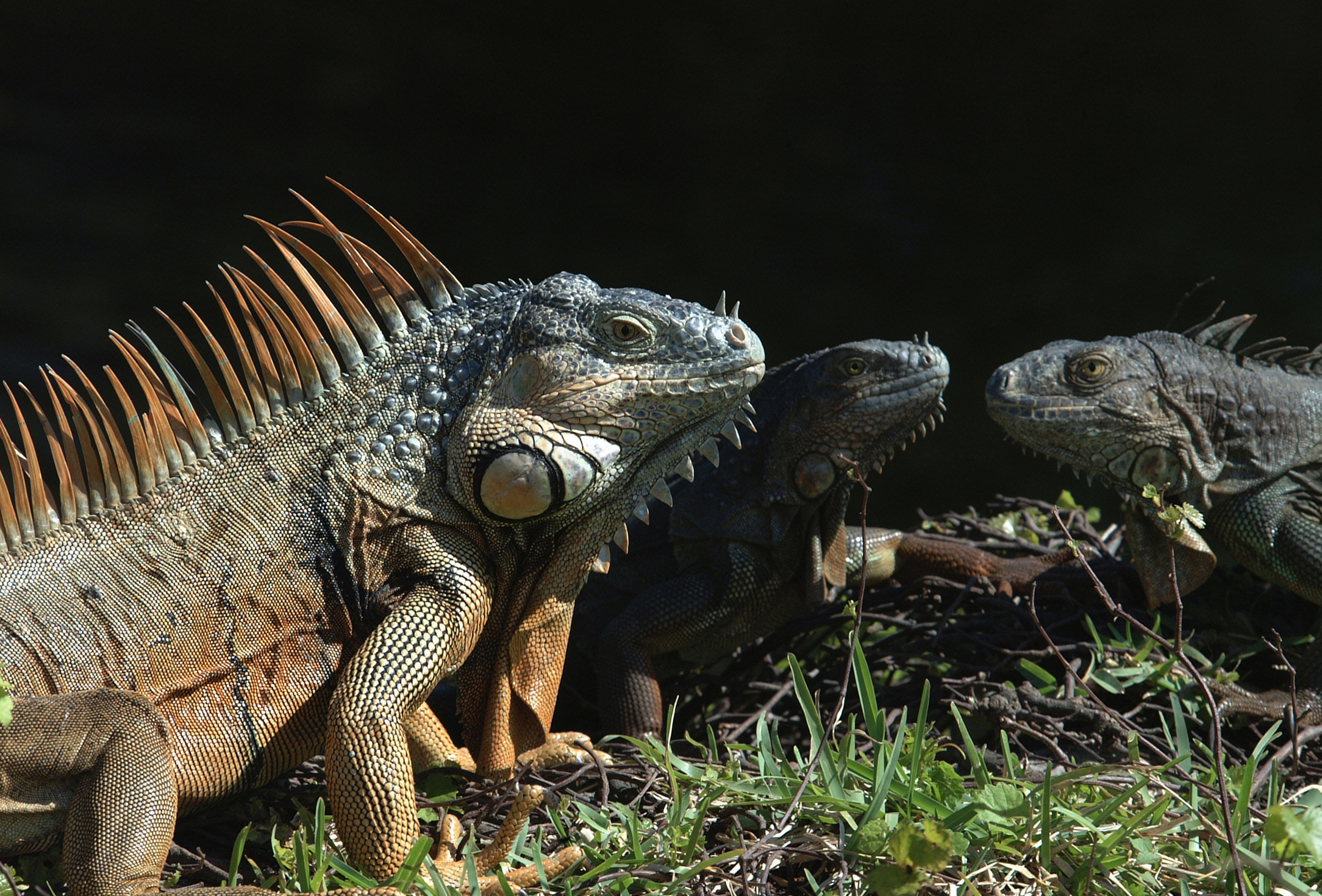Abstract
Esta publicación resume el conocimiento general sobre la iguana verde (Iguana iguana) en Florida. Es parte de una serie de publicaciones similares sobre reptiles establecidos en el estado. La biología y los impactos de algunas de estas especies son bien conocidos, mientras que otros están poco estudiados. Esta serie fue producida por estudiantes universitarios en el curso Ecología de Anfibios y Reptiles Invasores, en el otoño de 2020 en la Universidad de Florida. La serie fue diseñada para orientar a los propietarios de viviendas y otros residentes y visitantes curiosos sobre la diversidad de la vida silvestre de Florida. Nuestro objetivo es crear conciencia sobre los numerosos reptiles invasores introducidos en el estado, así como motivar a las personas a tomar medidas para reducir su propagación en Florida.
References
Garman, S. 1887. “On West Indian reptiles: Iguanidae.” Bulletin of the Essex Institute 19:25–50.
Krysko, K. L., L. A. Somma, D. C. Smith, C. R. Gillette, D. Cueva, J. A. Wasilewski, K. M. Enge, et al. 2016. “New Verified Nonindigenous Amphibians and Reptiles in Florida through 2015, with Summary of Over 152 Years of Introductions.” IRCF Reptiles & Amphibians 23:110–143. https://doi.org/10.17161/randa.v23i2.14119
Iannone, B. V, III, S. Carnevale, M. B. Main, J. E. Hill, J. B. McConnell, S. A. Johnson, S. F. Enloe, M. Andreu, E. C. Bell, J. P. Cuda, and S. M. Baker. 2020. “Invasive Species Terminology: Standardizing for Stakeholder Education.” Journal of Extension 58: https://joe.org/joe/2020june/a3.php https://doi.org/10.34068/joe.58.03.27
Dorcas, M. E., J. D. Willson, R. N. Reed, R. W. Snow, M. R. Rochford, M. A. Miller, W. E. Meshaka, et al. 2012. Severe Mammal Declines Coincide with Proliferation of Invasive Burmese Pythons in Everglades National Park. Proceedings of the National Academy of Sciences 197:2418-2422. https://doi.org/10.1073/pnas.1115226109
McCleery, R. A., A. Sovie, R. N. Reed, M. W. Cunningham, M. E. Hunter and K. M. Hart. 2015. “Marsh Rabbit Mortalities Tie Pythons to the Precipitous Decline of Mammals in the Everglades.” Proceedings of the Royal Society B 282: 20150120.http://dx.doi.org/10.1098/rspb.2015.0120
Miller, M. A., J. M. Kinsella, R. W. Snow, M. M. Hayes, B. G. Falk, R. N. Reed, F. J. Mazzotti, C. Guyer and C.M. Romagosa. 2017. “Parasite Spillover: Indirect Effects of Invasive Burmese Pythons.” Ecology and Evolution 8:830–840. https://doi.org/10.1002/ece3.3557
Farrell T. M., J. Agugliaro, H. D. S. Walden, J. F. X. Wellehan, A. L. Childress, and C. M. Lind. 2019. “Spillover of Pentastome Parasites from Invasive Burmese Pythons (Python bivittatus) to Pygmy Rattlesnakes (Sistrurus miliarius), Extending Parasite Range in Florida, USA.” Herpetological Review 50:73–76.
Krysko, K. L., K. M. Enge, and P. E. Moler. 2019. Amphibians and Reptiles of Florida. University of Florida Press, Gainesville. 706 pp.
Meshaka, W. E., Jr., H. T. Smith, E. Golden, J. A. Moore, S. Fitchett, E. M. Cowan, R. M. Engeman, S. R. Sekscienski and H. L. Cress. 2007. “Green Iguanas (Iguana iguana): The Unintended Consequence of Sound Wildlife Management Practices in a South Florida Park.” Herpetological Conservation and Biology 2:149–156.
Townsend, J. H., K. L Krysko, and K. M. Enge. 2003. “Introduced Iguanas in Southern Florida: A History of More Than 35 Years.” Iguana 10:111–118.
Meshaka, W. E., Jr., B. P. Butterfield, and J. B. Hague. 2004. The Exotic Amphibians and Reptiles of Florida. Kreiger Publishing Company, Malabar, FL. 155 pp.
Bock, B. C. 2004. Iguana iguana. An online reference. Available at www.iucn-isg.org/species/iguana-species/iguana-iguana/
King, W., and T. Krakauer. 1966. “The Exotic Herpetofauna of Southeast Florida.” Quarterly Journal of the Florida Academy of Sciences. 29:144–154.
Falcón, W., J. D. Ackerman, W. Recart, and C. C. Daehler. 2013. “Biology and Impacts of Pacific Island Invasive Species.” 10. Iguana iguana, the Green Iguana (Squamata: Iguanidae).” Pacific Science 2:157–186. https://doi.org/10.2984/67.2.2
Krysko, K. L., K. M. Enge, E. M. Donlan, J. C. Seitz, and E. A. Golden. 2007. “Distribution, Natural History, and Impacts of the Introduced Green Iguana (Iguana iguana) in Florida.” Iguana 1:2–17.
Kern, W. H., Jr. 2004. “Dealing with Iguanas in the South Florida Landscape.” EDIS 2004 (15). https://doi.org/10.32473/edis-in528-2004.
Sementelli, A., H. T. Smith, W. E. Meshaka, Jr., and R. M. Engeman. 2008. “Just Green Iguanas? The Associated Costs and Policy Implications of Exotic Wildlife in South Florida.” Public Works Management & Policy 12:599–606. https://doi.org/10.1177/1087724X08316157
Smith, H. T., W. E. Meshaka, Jr., G. H. Busch, and E. M. Cowan. 2007. “Gray Fox Predation of Nests as a Potential Limiting Factor in the Colonization Success of the Green Iguana in Southern Florida.” Journal of Kansas Herpetology 23:7–8.
Meshaka, W. E., Jr. 2011. “A Runaway Train in the Making: The Exotic Amphibians, Reptiles, Turtles, and Crocodilians of Florida.” Herpetological Conservation & Biology 6 (Monograph1):1–101.
Campbell, A., and E. Maple. 2012. “Home Range Size and Potential for Exotic Seed Dispersal by Green Iguanas (Iguana iguana) in Southern Florida.” Florida Scientist 75:96–99.
Florida Fish and Wildlife Conservation Commission. 2010. Miami Blue Butterfly Management Plan
U.S. Department of the Interior. 2012. Federal Register 77(67):20948–20986.
Croft, J. 2020. “Florida Bicyclist Injured in Collision with an Iguana.” CNN. https://www.cnn.com/2020/07/18/us/iguana-florida-bicycle-trnd/index.html
Smith, H. T., W. E. Meshaka, Jr., E. Golden, and E. M. Cowan. 2007. “The Appearance of the Exotic Green Iguana as Road-Kills in a Restored Urban Florida State Park: The Importance of an 11-Year Dataset.” Journal of Kansas Herpetology 22:14–16.
Rice, D. 2020. “‘Falling iguana’ alert issued in Florida due to cold temperatures: 'Don't assume that they're dead.’” USA TODAY. https://www.usatoday.com/story/news/nation/2020/01/21/falling-iguana-alert-florida-cold-weather/4533510002/
Engeman, R. M., H. T. Smith, and B. Constantin. “Invasive Iguanas as Airstrike Hazards at Luis Muñoz Marín International Airport, San Juan, Puerto Rico.” 2005. Journal of Aviation/Aerospace Education & Research 14:45–50. https://doi.org/10.15394/jaaer.2005.1518
Bautista-Trujillo, G. U., F. A. Gutiérrez-Miceli, L. Mandujano-García, M. A. Oliva-Llaven, C. Ibarra-Martínez, P. Mendoza-Nazar, B. Ruiz-Sesma, et al. 2020. “Captive Green Iguana Carries Diarrheagenic Escherichia coli Pathotypes.” Frontiers in Veterinary Science 7 (99): 1–9. https://doi.org/10.3389/fvets.2020.00099
Miller, K. 2020. “Invasive Iguanas: Burrowing Reptiles Blamed for $1.8M of Damages to Palm Beach Dam.” Palm Beach Post. https://www.tcpalm.com/story/news/local/florida/2020/01/21/iguanas-not-just-nuisance-these-lizards-contributed-1-8-m-repair-bill-west-palm/4530432002/

